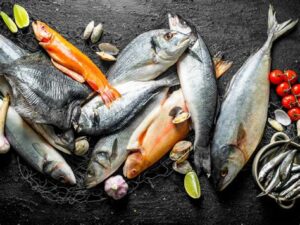Back to: Pre Vocational Studies JSS 2
Welcome to class
In our previous lesson, we learned about the different classes of fish based on habitat and morphology. Today, we’re going to go deeper into the numerous uses of fish and fish products, which play a vital role in our lives and economies.
Uses of Fish and Fish Products
Food

Fish is a highly nutritious food source, packed with protein, vitamins, and minerals, particularly omega-3 fatty acids, which are essential for human health. It is consumed by people all over the world in various forms, including:
- Fresh Fish: Whole or fileted fish, often grilled, baked, or fried.
- Canned Fish: Fish packed in cans, such as tuna, salmon, and sardines.
- Dried Fish: Fish that has been dried to preserve it, such as cod, haddock, and anchovies.
- Smoked Fish: Fish that has been cured and smoked, such as salmon, trout, and mackerel.
- Fish Paste: A paste made from ground fish, such as anchovy paste or cod paste.
- Sushi and Sashimi: Raw fish prepared in traditional Japanese styles, often served with rice, seaweed, and other ingredients.
- Fish Fingers and Nuggets: Processed fish products that are popular among children and adults alike.
Fish Products

In addition to eating fish directly, we also use fish products in various ways:
- Fish Oil: Extracted from fish tissue, fish oil is rich in omega-3 fatty acids, which have numerous health benefits, including reducing the risk of heart disease, stroke, dementia, and arthritis.
- Fish Meal: A protein-rich feed ingredient used in animal feed, particularly for poultry and livestock.
- Fish Gelatin: A gelatin extracted from fish bones and skin, used in various food and pharmaceutical products.
- Fish Glue: A glue made from fish bones and skin, used in woodworking and other crafts.
- Fish Leather: A leather-like material made from fish skin, used in fashion accessories and footwear.
- Fish Fertilizer: Fish waste products, such as fish meal and fish oil, can be used as organic fertilizers in agriculture.
Economic Importance

The fishing industry is a significant economic sector in many countries, providing jobs, income, and foreign exchange. It supports coastal communities, fishing fleets, and related industries such as processing, distribution, and retail. The fishing industry also contributes to the tourism sector, as many coastal areas attract visitors interested in fishing, seafood, and marine wildlife.
Environmental Factors
While fisheries provide numerous benefits, it’s important to consider their environmental impact. Overfishing and unsustainable fishing practices can deplete fish populations and damage marine ecosystems. Promoting sustainable fishing practices and protecting marine habitats is crucial for ensuring the long-term health and sustainability of our fisheries. This includes measures such as:
- Quotas: Limiting the amount of fish that can be caught in a given period.
- Marine Protected Areas: Establishing areas where fishing is restricted or prohibited to allow fish populations to recover.
- Bycatch Reduction: Implementing measures to minimize the capture of non-target species, such as dolphins, turtles, and seabirds.
- Aquaculture Management: Promoting sustainable aquaculture practices to reduce the pressure on wild fish populations.
Conclusion
Fish and fish products play a vital role in our lives, providing food, nutrition, and economic benefits. By understanding the various uses of fish and the importance of sustainable fishing practices, we can contribute to the conservation of our marine resources and ensure a healthy and sustainable future for fisheries.
Questions
- What are the primary nutritional benefits of fish?
- How is fish consumed in different cultures around the world?
- What are some common types of canned fish?
- What is the difference between smoked fish and dried fish?
- How are fish products like fish oil and fish meal used?
We have come to the end of today’s class. I hope you enjoyed the class!
In the next class, we shall be discussing the methods of fishing
In case you require further assistance or have any questions, feel free to ask in the comment section below, and trust us to respond as soon as possible. Well done so far and See you in the next class!
